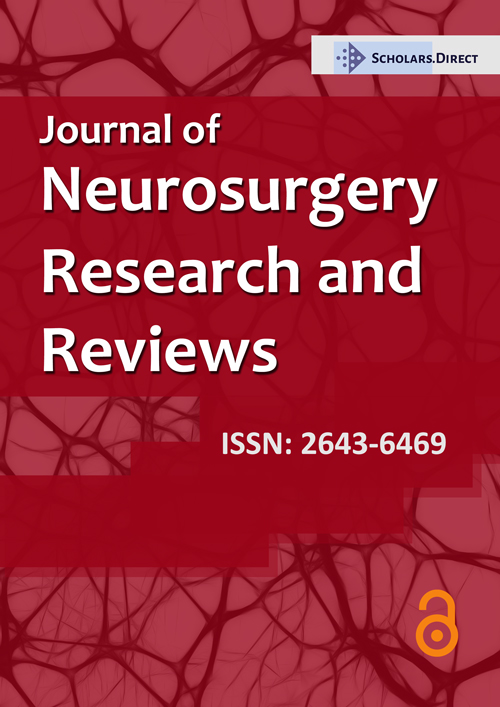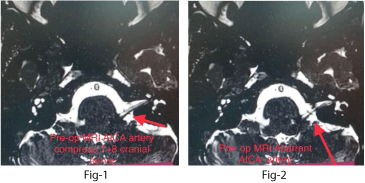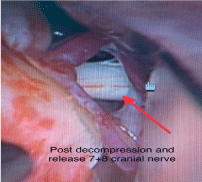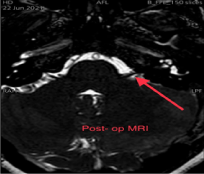Vestibular Paroxysmia Associated with Recurrent Episodes of Pulsatile Tinnitus: A Case Report and Review of the Literature
Abstract
Vestibular paroxysmia is defined as paroxysms of vertigo that could be presented with paroxysmal pulsatile tinnitus. It is usually caused by neurovascular compression of the vestibulocochlear nerve. The condition is responsive to carbamezabine. Refractory cases are treated with microvascular decompression. We present a case of vestibular paroxysmia of 27 years old patient that was her main presentation is tinnitus in addition to vertigo. She was treated with microvascular decompression (MVD).
Keywords
Vestibular paroxysmia, Tinnitus, Puslatile, Vascular compression, Vestibulo-cochlear nerve compression
Introduction
Vestibulocochlear nerve compression could present as episodic attacks of vertigo or pulsatile tinnitus caused by vascular compression of the vestibulocochlear nerve [1,2]. The pulsatile nature of the episodes is caused by the nature of the vascular compression [3]. Vestibular Paroxysmia is a rare disease, believed to be the cause of 4% of all dizziness conditions. The anterior inferior cerebellar artery (AICA) is thought to be the cause of 75% of vestibular paroxysmia cases.
Although seen less frequently, other blood vessels have been reported as a cause of this rare entity including: posterior inferior cerebellar artery (PICA) in 5% of the cases, the vertebral artery with 10% occurrence and the veins in 10% of the cases [4,5].
Fast sodium channel blockers such as Carbamazepine and Oxcarbazepine could be the main treatment in these patients, as they prove their efficacy in decreasing attacks' frequency. In addition, they decrease the intensity of the attack [3].
The surgical treatment should be offered in the refractory cases, or those who has side effects related to the drugs [6].
Herein, we report a rare case of a 27-year-old female patient who presented with pulsatile tinnitus, diagnosed as a case of vestibular paroxysmia, and treated with microvascular surgical decompression.
Case Report
A 27-year-old female presented to our clinic with a 14 years history of episodic pulsatile tinnitus. The tinnitus was left sided, that is continuous, increases in quite ambient, with stress and upon waking up in the morning. It decreases with the use of headphones and with compressing the left side of the neck. Upon further questioning, the patient reports 6 episodes of vertigo over the last 3 years. Each episode lasted 2 minutes, it was not related to any certain provocation. The patient did not report headaches and does not have a family history of migraine. There is no history of seizures, or family history of epilepsy. The patient had been evaluated multiple times by ENT specialists. She had undergone different investigations with no apparent diagnosis.
In neurological examination, the patient was conscious, oriented, and alert. Cranial nerves examination was intact with no apparent abnormality. She had normal motor, sensory and cerebellar examination. The patient had negative Dix-Hallpike test, Romberg test, Hoffman's test, and Babinski sign.
Brain magnetic resonance imaging (MRI) was performed and showed left aberrant anterior inferior cerebellar artery, compressing the left vestibule-cochlear nerve and the left facial nerve.
(Figure 1) and (Figure 2) preoperative MRI showing aberrant AICA artery compressing the vestibulocochlear and the facial nerve.
For this reason and based on the above findings the patient underwent left retro-mastoid, retro-sigmoid craniotomy for microvascular decompression of the AICA was done (Figure 3) and (Figure 4). No intraoperative complications have been reported. The patient was doing well after the surgery, with intact cranial nerves, no motor or sensory deficits. The tinnitus significantly improved in the first day, and this proves that aberrant AICA was the cause of her symptoms.
The patient was discharged, after 4 days of surgery, on Carbamazepine, dexamethasone, analgesics and PPI. On follow up, the tinnitus improved with no reported complications after the surgery.
Discussion
The patient presented with paroxysms of tinnitus and vertigo. Based on negative Dix-Hillpike maneuver and the results of MRA, benign positional vertigo and vertebra-basilar insufficiency were excluded. Clinical picture was useful to exclude Meniere's disease and perilymphatic fistula. Due to the absence of headaches vestibular migraine were not taken into consideration. Our patient follows the criteria for probable diagnosis of vestibular paroxysmia, as she had 6 episodes of vertigo, lasting two minutes, not provoked and not contributed to any other diagnosis [7]. But this case was special, as the main complaint of the patient was related to tinnitus, and vertigo was not even mentioned by the patient, until we have asked her thoroughly about it. The presentation of tinnitus made it more difficult to investigate and to interpret.
Pulsatile tinnitus has a range of differential diagnosis, including glomus tympanicum, dural AV fistulas and carotid artery abnormalities, all of them were excluded based on the imaging findings and clinical presentation [8].
The subjective nature of tinnitus makes it difficult to interpret. It was evident in the past years that tinnitus could be caused by neurovascular compression of the 8th cranial nerve, or arachnoiditis at the cerebellopontine angle [9,10]. The literature argues about the possibility of tinnitus with compression, due its vague nature. This was also evident in the fact that only 44-70% of patients responded to MVD [11-14].
It is worthy to note that tinnitus presentation is rare in VIII compression, and until the moment of publishing this case report, there are no criteria related to tinnitus as a presentation [15]. Prior studies have suggested different presentations of the tinnitus associated with the compression, as some described it to be pulsatile in nature, and others report continuous tinnitus. It is evident, that tinnitus could present both with pulsatile or continuous nature [16-20].
Neurovascular compression usually affects the intracisternal part of the nerve, with a range of 0-10.2 mm distance from the internal acoustic porus [16,21]. This part is vulnerable to compression due its covering; this is the site of transition from central myelin to Schwann cell. The vestibulocochlear nerve is the largest nerve to have the central myelin portion [22].
The radiological evidence of neurovascular compression is considered sensitive but not specific feature of the condition [23].
Microvascular decompression is a well-established for multiple conditions like trigeminal neuralgia. Yet it the role of decompression in vestibulocochlear nerve is still controversial. The surgical decompression success rate to relive tinnitus has low percentage. This is explained due to subjective nature of the presentation of tinnitus and the complexity of the surgery. Moreover, it has been postulated that the compression changes centrally located nuclei, and that would not be relieved with surgery. The complexity of the surgery has few reasons, the vascular compression implied on the cochlear nerve could be found along the whole nerve. Furthermore, there is always a risk of injury to the AICA during mobilization [24,25].
Multiple factors have been elucidated to predict the outcome of MVD. Young females, presentation unilateral tinnitus of short duration and those with unaffected hearing would have better outcomes after the surgery [25-29].
Literature Review
Bibliography research is made with PubMed using the keywords “Vestibular paroxysmia”. The research result was 93 articles. We included in this literature review 29 articles. Studies were published from 1994 to 2021.
References
- Brandt T, M Dieterich (1994) Vestibular paroxysmia: Vascular compression of the eighth nerve? Lancet 343: 798-799.
- Chang TP, YC Wu, YC Hsu (2013) Vestibular paroxysmia associated with paroxysmal pulsatile tinnitus: A case report and review of the literature. Acta Neurol Taiwan 22: 72-75.
- Hüfner K, Barresi D, Glaser M, et al. (2008) Vestibular paroxysmia: Diagnostic features and medical treatment. Neurology 71: 1006-1014.
- Brandt T, M Strupp, M Dieterich (2016) Vestibular paroxysmia: A treatable neurovascular cross-compression syndrome. J Neurol 263: S90-S96.
- Christoph Best, Joachim Gawehn, Heidrun H Krämer, et al. (2013) MRI and neurophysiology in vestibular paroxysmia: Contradiction and correlation. J Neurol Neurosurg Psychiatry 84: 1349-1356.
- Michael Strupp, Sebastian von Stuckrad-Barre, Thomas Brandt, et al. (2013) Teaching neuroimages: Compression of the eighth cranial nerve causes vestibular paroxysmia. Neurology 80: e77.
- Michael Strupp, Jose A Lopez-Escamez, Ji-Soo Kim, et al. (2016) Vestibular paroxysmia: Diagnostic criteria. J Vestib Res 26: 409-415.
- Guner Sonmez, C Cinar Basekim, Ersin Ozturk, et al. (2007) Imaging of pulsatile tinnitus: A review of 74 patients. Clin Imaging 31: 102-108.
- House JW (1981) Management of the tinnitus patient. Ann Otol Rhinol Laryngol 90: 597-601.
- Jannetta PJ (1975) Neurovascular cross-compression in patients with hyperactive dysfunction symptoms of the eighth cranial nerve. Surg Forum 26: 467-469.
- Adams CB (1989) Microvascular compression: An alternative view and hypothesis. J Neurosurg70: 1-12.
- MB Møller, AR Møller, PJ Jannetta, et al. (1993) Vascular decompression surgery for severe tinnitus: Selection criteria and results. Laryngoscope 103: 421-427.
- Brookes GB (1996) Vascular-decompression surgery for severe tinnitus. Am J Otol 17: 569-576.
- Vasama JP, MB Moller, AR Moller (1998) Microvascular decompression of the cochlear nerve in patients with severe tinnitus. Preoperative findings and operative outcome in 22 patients. Neurol Res 20: 242-248.
- H Ryu, S Yamamoto, K Sugiyama, et al. (1998) Neurovascular decompression of the eighth cranial nerve in patients with hemifacial spasm and incidental tinnitus: An alternative way to study tinnitus. J Neurosurg 88: 232-236.
- H Ryu, S Yamamoto, K Sugiyama, et al. (1998) Neurovascular compression syndrome of the eighth cranial nerve. What are the most reliable diagnostic signs? Acta Neurochir (Wien) 140: 1279-1286.
- Kudo T, IK (1984) Microvascular decompression of the eighth cranial nerve for disabling tinnitus without vertigo: A case report. Neurosurgery 14: 338-340.
- Lesinski SG, CA Komray R, et al. (1979) Why not the eighth nerve? Neurovascular compression-probable cause for pulsatile tinnitus. Otolaryngol Head Neck Surg 87: 89-94.
- Meyerhoff WL, B E Mickey (1988) Vascular decompression of the cochlear nerve in tinnitus sufferers. Laryngoscope 98: 602-604.
- R J Wiet, DR Schramm, RP Kazan (1989) The retrolabyrinthine approach and vascular loop. Laryngoscope 99: 1035-1039.
- H Ryu, S Yamamoto, K Sugiyama et al. (1999) Neurovascular compression syndrome of the eighth cranial nerve. Can the site of compression explain the symptoms? Acta Neurochir (Wien) 141: 495-501.
- Lang J (1982) [Anatomy, length and blood vessel relations of "central" and "peripheral" paths of intracisternal cranial nerves]. Zentralbl Neurochir 43(3): 217-258.
- Nishanth Sivarasan, Philip Touska, Louisa Murdin, et al. (2019) MRI findings in vestibular paroxysmia - An observational study. J Vestib Res 29:137-145.
- Nicolas Guevara, Arnaud Deveze, Valeriu Buza, et al. (2008) Microvascular decompression of cochlear nerve for tinnitus incapacity: Pre-surgical data, surgical analyses and long-term follow-up of 15 patients. Eur Arch Otorhinolaryngol 265: 397-401.
- MB Møller, AR Møller, PJ Jannetta, et al (1986) Diagnosis and surgical treatment of disabling positional vertigo. J Neurosurg 64: 21-28.
- D De Ridder, H Ryu, G De Mulder, et al. (2005) Frequency specific hearing improvement in microvascular decompression of the cochlear nerve. Acta Neurochir (Wien) 147: 495-501.
- S Felber, G Birbamer, F Aichner, et al. (1992), Magnetic resonance imaging and angiography in hemifacial spasm. Neuroradiology 34: 413-416.
- WA Friedman, BJ Kaplan, D Gravenstein, et al. (1985) Intraoperative brain-stem auditory evoked potentials during posterior fossa microvascular decompression. J Neurosurg 6: 552-557.
- Y Ko, CW Park (1997) Microvascular decompression for tinnitus. Stereotact Funct Neurosurg 68: 266-269.
Corresponding Author
Dr. Ahmad M Daqour, Department of Neurosurgery, Al-Makassed Islamic Charitable Hospital, Palestine, Tel: +970546016522.
Copyright
© 2021 Daqour AM. This is an open-access article distributed under the terms of the Creative Commons Attribution License, which permits unrestricted use, distribution, and reproduction in any medium, provided the original author and source are credited.







